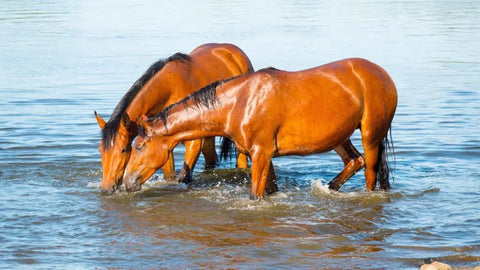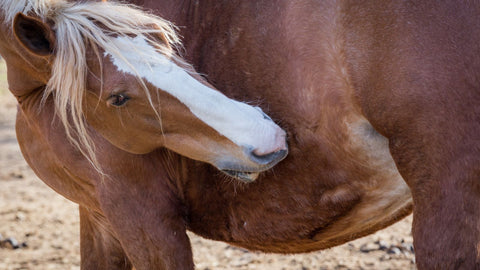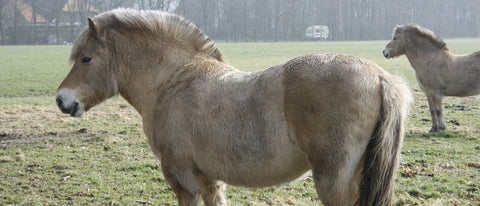
Florian ist aufgewachsen auf einem Bauernhof. Umgeben von Pferden, entdeckte er früh seine Faszination für diese majestätischen Tiere. Inspiriert von seiner reitbegeisterten Mutter, entwickelte er das Nahrungsergänzungmittel - Pferdegold. Seine tiefe Verbundenheit zur Natur und die leidenschaftliche Hingabe zu Pferden trieben ihn an, sein Unternehmen zu gründen.
The human groans – and sweats. What can a horse say? Genetically, horses are still steppe animals , and it's much cooler there than in our latitudes. No wonder that in this blazing heat, many four-legged animals quickly become exhausted. Possible consequences: sunstroke and heatstroke .
According to a study , warm, humid weather is a particular problem. The website of the University of Guelph in Canada states: Just 17 minutes of moderate exercise in hot, humid weather is enough for a horse's body temperature to rise dangerously . By comparison, it takes three to ten times as long for humans.
The folding trick
Horses sweat and lose water, exorbitant amounts. There's a simple trick to determine whether your horse has drunk enough.
You grasp the skin on the neck with your hand and form a fold . Hold it for a few seconds and then release. If the skin immediately smooths out, everything's fine. If it doesn't and remains wrinkled, the horse clearly hasn't been drinking enough.
Be careful, dehydration!
If a horse isn't sweating at all, it's probably severely dehydrated. The body is already so dehydrated that there's no fluid left for sweating. Then it's time to take the horse into the shade immediately, give it lukewarm water, preferably in small portions, and call the vet!
8 cool tips for your horse on hot days
The best thing to do is prevent it from happening in the first place. Here are our tips to help your horse survive the hot days.
Find a shady spot for your horse
The four-legged friends must always have the opportunity to find a shady spot , for example, under trees. A single tree in the entire pasture isn't enough; after all, even the lower-ranking horses should have a chance.
Give your horse enough water
A lot of water is lost through sweating – water that the body then lacks. Therefore, your horse should always have access to fresh water – not just in the stable, but also in the pasture. When riding, ideally, you have a water source nearby, such as a stream or lake.
Riding out yes: But only at the right time
You shouldn't run a marathon at midday, when the sun is at its highest and blazing down on your head. Therefore, your ride should also take place at a cooler time of day . It's best to go riding in the early morning or evening.

Not too sporty
During hot weather, it's better to slow down . Exercise is much more strenuous in high temperatures – and the risk of dehydration is even greater. Therefore, choose shorter distances at a moderate pace. And plan regular breaks in the shade, ideally with an opportunity to drink.
Water on!
What could be better than jumping in the shower after a workout and washing away all that sweat? Our four-legged friends feel the same way. Your horse will certainly appreciate a shower . A positive side effect: A clean coat is far less attractive to some parasites.
The right hairstyle
If the coat is too thick, you should consider using clippers . Another proven effective approach is braiding your dog's hair . This allows for plenty of air to reach the skin.

Pferdegold® Electrolytes
The product Pferdegold Electrolytes replenishes your horse's electrolyte levels. Electrolytes are vital – and often in short supply, especially in summer and/or during strenuous physical activity. Water and vital minerals are lost through sweating.
Order nowAlways nice and airy
The air in the stable is often stuffy. Therefore, you should ensure it is well ventilated. Cross ventilation is a good idea. Opening opposite windows and doors creates a pleasant breeze. In a pinch, a fan will also do. Caution: Risk of injury: Please do not place this directly next to the horse. And also pay attention to the cables.
A round of electrolytes for everyone!
When we sweat, we lose not only water but also electrolytes . These include minerals, trace elements, and salts that play important roles in the cells. Since the horse's body cannot produce electrolytes itself, they must be replenished.
Salt consists primarily of sodium chloride, which is composed of the two electrolytes sodium and chlorine. A 500-kilogram horse typically needs at least 10 grams daily. In hot weather and particularly demanding conditions, this can be between 80 and 100 grams. Hay, for example, contains virtually no salt.

Source: slawik.com
Many therefore resort to "horse lollipops," or salt licks. A good idea in principle, but unfortunately only half the battle. These lollipops usually lack certain minerals—including magnesium, potassium, and calcium.
You should therefore treat your four-legged friend to a round of electrolytes on sweaty days.

















